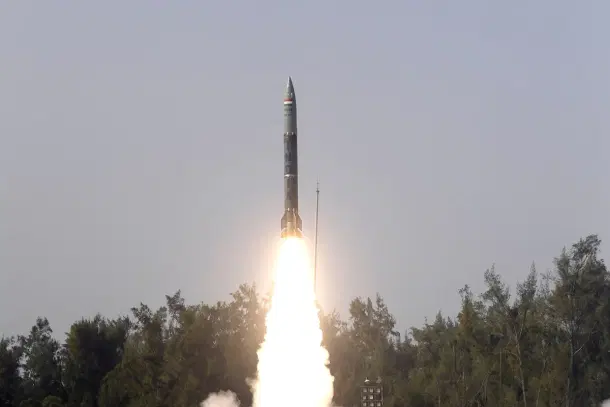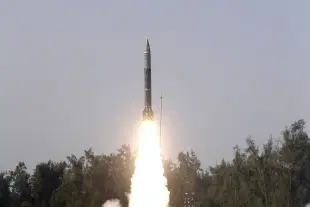Defence
What We Know About Pralay — The Indian Missile Designed To Strike Chinese Bases In Tibet
Swarajya Staff
Jul 29, 2025, 03:31 PM | Updated 03:31 PM IST
Save & read from anywhere!
Bookmark stories for easy access on any device or the Swarajya app.


In a major step toward building its own conventional missile force, India’s DRDO successfully carried out two consecutive flight-tests of the Pralay quasi-ballistic missile on 28 and 29 July from the Dr APJ Abdul Kalam Island off the Odisha coast.
Pralay is India’s first indigenously built tactical quasi-ballistic surface-to-surface missile. Approved in 2015, the missile was derived from technologies used in the K-series submarine-launched ballistic missiles and India’s ballistic missile defence (BMD) programme.
The first known tests of the Pralay missile were conducted on two consecutive days in December 2021. With a range of 150 to 500 km, the missile is designed to target high-value enemy assets like air bases, radars, logistics hubs, and missile sites.
Weighing around 5,000 kg, Pralay is road-mobile platform, giving it rapid deployment capability and enhanced survivability. It can carry conventional warheads between 350 and 1,000 kg, including fragmentation, penetration-cum-blast, and runway-denial submunitions.
What sets Pralay apart is its quasi-ballistic trajectory. It flies low, can manoeuvre mid-air, and is designed to evade interception by enemy missile defence systems.
Unlike traditional ballistic missiles that follow a high-arching, predictable path governed largely by gravity after the boost phase, Pralay travels on a flatter, depressed trajectory. This lower flight profile dramatically reduces the time it remains visible to radar systems, giving enemy defences a much shorter window to detect, track, and intercept it.
But what truly gives Pralay its edge is mid-course manoeuvrability. After launch, the missile can alter its flight path during the terminal phase using advanced control surfaces and guidance systems. This makes it much harder for enemy interceptor missiles, especially those relying on trajectory prediction, to hit it.
This quasi-ballistic nature blends the speed and range of ballistic missiles with the agility and unpredictability of cruise missiles, creating a highly survivable battlefield weapon. It allows Pralay to bypass heavily defended zones, punch through anti-missile shields like China’s HQ-9 or Pakistan’s LY-80, and accurately hit time-sensitive or fortified targets such as air defence sites, missile batteries, and command centres.
The satellite imagery of the test shows that Pralay is a canisterised road-mobile system. Canisterisation can significantly enhance the mobility of a tactical missile system by reducing the time and resources required to prepare and launch the missile.
The mobility of a tactical missile system is important because it allows the system to be moved to different locations as needed in order to respond to evolving threats.
The Indian Army has already approved the acquisition of 120 Pralay missiles, and reports indicate the number could go up to 370. The missile is expected to be deployed along both the Line of Actual Control with China and the Line of Control with Pakistan.
Pralay is set to become a key pillar of India's proposed Rocket Force, a dedicated tri-services command being planned to unify India’s conventional missile arsenal. It will be a counter to China’s PLA Rocket Force (PLARF), which commands thousands of conventional and nuclear missiles, including short-range ballistic missiles like the DF-15 and DF-16.
While the Strategic Forces Command handles India’s nuclear arsenal, the IRF would focus purely on conventional missile warfare. With Pralay, India is inching closer to building a credible counter to China’s missile-heavy posture.
The missile’s success has generated interest from other countries as well. Armenia, which has emerged as one of the largest importers of Indian military platforms in recent years, is reportedly pushing India to sell it the tactical ballistic missile.





